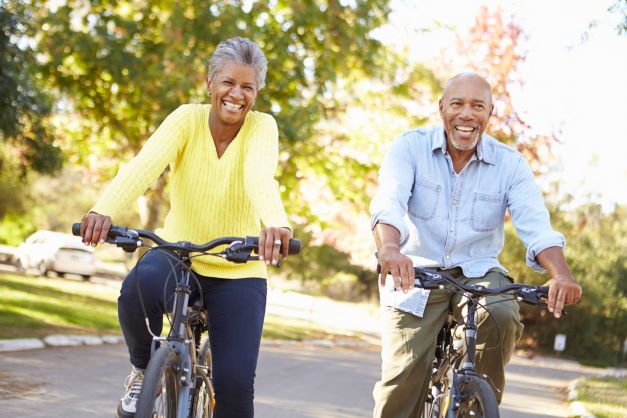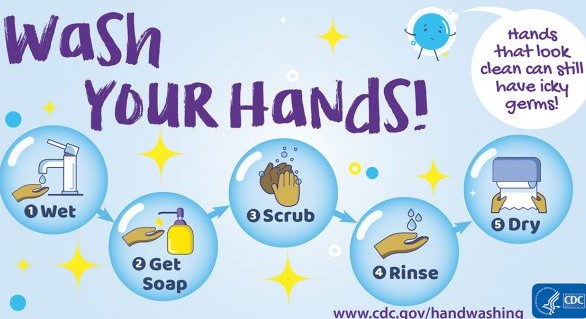In this edition
- What is health literacy, why is it important, and what can I do?
- The Indigenous people of Nevada
- Global Handwashing day
- Apple Salad
About the Newsletter
This month's issue of Healthy Living while Aging focuses on health literacy - the importance of it and what we can do to improve it. Patient empowerment leads to health literacy which allows us to have better health outcomes.
What is health literacy, why is it important, and what can I do?
By Patricia Swager, M.Ed.
Patricia Swager is the director of the Nevada Geriatric Education Center and the clinical education director at University of Nevada, Reno, Sanford Center for Aging, a unit of the University's School of Medicine.

A couple riding bikes together in a park.
My husband had surgery and was in a lot of pain. We spoke to the doctor, and she provided a more potent pain medication. I left the office thinking I knew what to do. If the first medication isn’t enough, then give him the second medication. I did exactly that, only to realize that my husband was over-medicated. I had to keep waking him up to breath e until the medication wore off. Thank goodness it was during the day and I was home with him. On his follow-up appointment, I found out that we were supposed to wait four hours before giving him the second medication. Neither the doctor nor I wrote down what was said. Also, neither of us confirmed that I understood what to do. Health literacy is your ability to find, understand and use health information; make “well-informed” decisions; and act on them. This relates to you personally and others in your life and your community. Nearly nine out of 10 adults have difficulty using everyday health information.
Government websites are a good source for health literacy and other health information on diabetes, nutrition and physical activity. If you search for “.gov” websites, the Google site can be a good source of reliable and accurate information. When you think about a health condition, ask yourself these questions:
- What do I know or need to know more about this health condition?
- Where could I go to get more information or to find out about services offered?
- What happens if I don’t take control of this health condition?
- What new habit could I start to improve my health?
- What are the benefits of doing this new habit?
It is important for you to think about what matters to you. What changes you can make to improve your quality of life? Perhaps you want to drink more water, exercise and eat more vegetables. Choose one habit and focus on that habit. Start with a small goal and increase slowly. Once you have mastered that one, start focusing on the next habit. Your expertise may be in construction, sewing, accounting or another area. Just like others are not familiar with your area of expertise, you may not be familiar with health information. So, I encourage you to:
- Ask lots of questions
- Clarify information and sources of information
- Identify what you can and want to do
- Make a plan and adapt it when needed
- Celebrate your success
- Encourage others
Be the best that you can be!
Learn more about the author
The Indigenous people of Nevada
October 11 is Indigenous People Day. To celebrate, let’s look at the indigenous people of our silver state. There Native American Territory is home to the Great Basin Tribes: Washoe, Northern Paiute, Southern Paiute, and Western Shoshone. Across the nation, there are 574 federally-recognized tribes, all uniquely different and all are sovereign nations. In Nevada, there are 20 federally-recognized tribes, comprised of 28 separate reservations, bands, colonies and community councils. Indigenous People have made numerous contributions to our society historically and in present day. Sarah Winnemucca, born in 1844 was a member of the Paiute Tribe in present-day Nevada. She worked as both an interpreter and negotiated between American Indian tribes and the United States Army during the "Indian wars" that occurred throughout the American West in the decades after the Civil War. As a skilled writer and activist, she demanded that Americans live up to their own political ideals, exposing the violence and hypocrisy that accompanied western expansion in her quest to secure her people "a permanent home on their own native soil".
Today, Native American leaders hold many important positions and work to continue to address challenges and make many contributions to society. As we celebrate Indigenous People's Day. As we acknowledge and honor the invaluable contributions and achievements of so many of our Indigenous People throughout history and today.
Global Handwashing day

Infographic showing the five steps for effective handwashing.
Follow the five steps for effective handwashing to help prevent the spread of germs and keep you and others healthy.
- Wet your hands with clean, running water (warm or cold), turn off the faucet and apply soap.
- Lather your hands by rubbing them together with soap.
- Lather the backs of your hands, between your fingers and under your nails.
- Scrub your hands for at least 20 seconds. If you hum the “Happy Birthday” song twice from beginning to end, that’s about 20 seconds!
- Rinse your hands well under clean, running water.
- Dry your hands with a clean towel or air dry them.
Why? Read the science behind the recommendations.
Apple Salad

Apple salad ingredient illustration by Jessie Boulard.
For apple month, we are sharing a recipe from the “Healthy Cooking the Anishinaabek Way” cookbook. The cookbook is a collaborative collection of recipes created and produced through the Inter-Tribal Council of Michigan’s Tribal Food Access Coalition and Walmart Healthy Native Foods Project. Thank you to ITCMI for their permission to share this recipe with our Nevada seniors.
To view the entire cookbook, click here
Notes and ideas:
- A mix of apples works well in this salad
- This dish is best eaten on the day it is made
- Vanilla yogurt can be used in place of plain yogurt
- A dried fruit and nut mix can
Ingredients
- 3 large, tart apples, washed
- 1 tablespoon lemon juice
- 2 ribs celery, washed
- ½ - ¾ cup walnuts or pecans
- ½ cup dried cranberries OR raisins OR dried cherries
OR a mix of all
- ½ cup plain Greek yogurt
- ½ teaspoon cinnamon
- 2 - 4 tablespoons maple syrup OR maple sugar
Directions
- Wash apples. Core and dice apples into bite-sized pieces and place in a bowl. Sprinkle with the lemon juice and toss gently to coat all pieces with lemon juice.
- Wash celery and slice thin. Chop nuts into small pieces.
- Add celery, nuts and dried fruit to bowl with apples, and mix well.
- Mix the yogurt with cinnamon and maple syrup or sugar in a small bowl. Pour over apple mixture and toss together gently. Let mixture sit in refrigerator for about 30 minutes before serving.
Published by:
Swager, P., Emm-Hooper, D., 2022, Healthy Living while Aging! (2022-10), Extension | University of Nevada, Reno, Newsletter, Volume 3, Issue 10
An EEO/AA Institution. Copyright ©
2025, University of Nevada Cooperative Extension.
A partnership of Nevada counties; University of Nevada, Reno; and the U.S. Department of Agriculture


